SaaS in 2022 will be a year of growth and innovation with heavy focus on the customer experience. With the impact of COVID-19 on every area of business and consumer needs changing, the SaaS industry underwent radical but essential change throughout 2020 and 2021.
To succeed, companies needed digitization and more flexibility in their solutions. As a result of the industry shifts from COVID-19, the world is expected to keep moving towards these customer needs.
These overall sentiments guide the direction SaaS is headed in 2022:
- Simplicity
- Personalized Experiences
- Security
- Value for Money
The global SaaS industry is projected to reach $307 billion by 2026. To increase your size of that pie, a focus on customer experience is key. SaaS companies have the potential to double their revenue within 36 months by focusing on CX.
A positive experience means customers are less likely to abandon purchases and more likely to spend more. 86% of buyers are more apt to pay more if they are provided a great customer experience.
Here’s where we see the SaaS industry headed in 2022…
#1: Mobile First
SaaS companies need to have a Mobile First Experience on their website and software
SaaS is typically thought of as providing mostly a desktop-first experience. With the complexity and vast offerings of SaaS services, mobile devices have often been a second thought. The limitations of a mobile device haven’t always gone hand in hand with a SaaS product experience.
Mobile devices have continued evolving rapidly. In the most recent years, SaaS companies have taken an approach to figure out how to best leverage mobile devices and make their products and services more mobile-friendly for active users.
Creating mobile-first experiences soon won’t be just a nice-to-have, but an essential for reaching your target audience and engaging with your current customers. There are a couple key reasons for this:
A growing market:
- With more SaaS companies recognizing this opportunity, the corporate mobile market for SaaS is expected to grow to $7.4 billion in 2022.
- 52% of all internet traffic comes from mobile, while desktop usage trends on a decline.
A demand for a well-designed mobile CX:
- 57% of customers won’t recommend a business with a poorly designed website on mobile.
- 50% of customers will stop visiting a website that isn’t mobile-friendly, even if they like the business.
#2: Value Over Bundling
Pricing models that provide value over bundling are more likely to get conversions
SaaS services have traditionally been provided to customers in the format of a bundle. Once the bundle was received, customers would then determine which aspects of the bundle they would use.
COVID-19 made many customers realize that they had been paying for services that they didn’t need or use when determining where budgets needed to be cut. Many customers felt that they were wasting money on unused services, and weren’t getting as much value for their money as they could be.
Bare-Bones Model
To meet customer needs, more and more SaaS companies have taken a hard look at their business offerings and started to unbundle their services. They take a hard look at what their services core functionality is, and what those “add-ons” would be. After determining this new business model, customers can choose what “add-ons” they want to choose in addition to the pared-down core services.
By taking a value-first approach over bundling, you get ahead of competitors who haven’t yet taken this step. For example, 40% of SaaS companies have reported taking on a value-based pricing model, meaning the majority are still focusing on the old model.
Transaction-Based Model
Similar to creating a value-first approach, a way to optimize for what customers really need and add value to their experiences with your business is by creating transaction-based models with your SaaS service.
Instead of enforcing a subscription-based model, some SaaS companies have started to operate on a “pay-per-use” type of model. Similar to unbundling, clients have realized in recent years that they only want to pay for what they’re using.
One leading example of a company using the transaction-based model is Amazon Web Services (AWS). AWS has used a pay as you go transaction model from the start. This model allows customers to adapt as their business needs change over time, and doesn’t leave unused services on the table.
This model pays off for AWS. They have consistently held about ⅓ of the cloud infrastructure market share since 2017.
SaaS Sales Models Shifts
The pricing models themselves are shifting in 2022, but so is the way that SaaS is sold to potential customers. SaaS sales interactions have changed as a result of the pandemic.
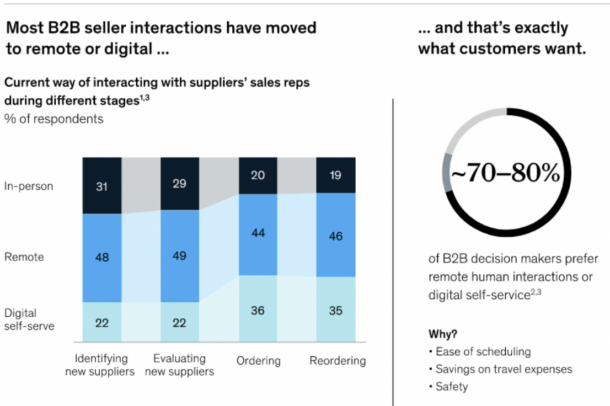
B2B seller interaction data from McKinsey
From research done by McKinsey, there has been a massive shift towards digital in the B2B sales space. The impact on the SaaS industry has been one to focus more on remote and digital self-serve selling tactics rather than in-person. Customers are moving along the sales funnel without in-person interaction more than ever. Particularly, ordering and reordering are vastly focused on remote and digital self-serve.
The good news is that the vast majority of customers prefer remote interaction or digital self-service. By allowing customers to self-serve or selling remotely, you give your customers what they want!
#3: Service Offerings
Provide Implementation and Consultancy Services as part of your offerings
Continuing the theme of excellent customer experiences, SaaS companies seek out ways to help their customers get the most out of their products. A growing trend is the focus on offering not just a product, but expertise as well.
A currently growing market for SaaS companies is providing services to help clients implement and use their products to the best of their abilities. According to Gartner, nearly 19% of cloud budgets are used on consulting, migration, and implementation services. This number is only rising, with an expectation of budgets increasing to 28% in 2022.
Adobe Creative Cloud is one of the most popular and widely used SaaS companies. Adobe also offers the Experience Cloud, a B2B marketing automation platform. Along with Adobe Experience Cloud, Adobe offers a wide range of professional services to help maximize customers’ usage of their products. From audits to implementation to strategy, Adobe offers expertise on top of the products they provide.
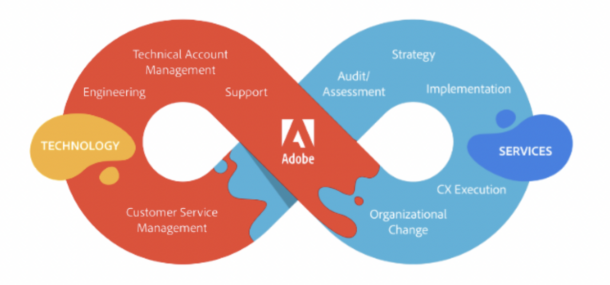
Adobe’s visual representation of their services offered
Another example of a company offering these services is Tableau. Tableau offers professional services in the form of both strategy and execution. SaaS companies will continue to adopt this model to boost revenue and help customers have a stronger experience when using their products.
#4: Build Trust
Ensuring security & reliability are key features and messages
Staying secure and safe online has been a huge focus spanning businesses from all industries. High profile hacks in recent years have brought security to the forefront as a key focus area in our digital world. Technology companies particularly have had to hone in on security and how to best serve secure experiences to their customers.
Impact of Security Breaches
Data breaches are incredibly damaging to a company’s reputation and to customer’s information. Not only do data breaches hurt the reputations of companies, but they also hurt companies profits. Data breaches lead to higher churn rates and a costly impact on SaaS businesses A study done by IBM Security and Ponemon Institute researched these costs.
One of the biggest takeaways was that the cost of a data breach increases when there are more records lost and a higher churn rate. If less than 10,000 records are lost, the average cost of a data breach is $4.5 million. If the average number of records lost was higher than 50,000, that cost jumps to $10.3 million.
In terms of churn rate, if companies only have a churn rate over less than 1% following a data breach, the average cost is $5.3 million. However, if that churn rate is greater than 4%, the cost of the breach is $10.1 million.
In 2021, data breach costs increased significantly from 2020. The average cost jumped from $3.86 million in 2020 to $4.24 million in 2021, making it even more valuable to have airtight security for your SaaS business.
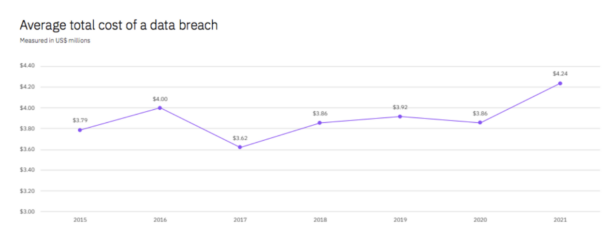
Total average data breach cost identified by the IBM Cost of a Data Breach Report 2021
Where do these costs come from?
As identified by the IBM Cost of a Data Breach Report 2021, the largest costs (38%) from a data breach come from lost business. This is followed by detection and escalation at 29% of costs.
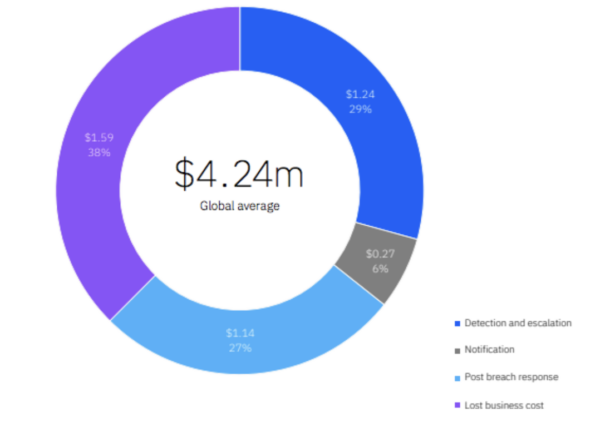
Breakdown of cybersecurity breach costs by IBM Cost of a Data Breach Report 2021
Artificial Intelligence in Security
Artificial intelligence (AI) has been largely impacting how companies approach security today. What artificial intelligence does is help automatically detect and remove potential security threats that come across the business.
With cyber attacks increasing in both volume and complexity, AI assists security teams beat security threats to the punch. AI technology uses machine learning and processing to identify objects and threats, and reduce response times.
Implementing AI to help with cybersecurity has financial benefits as well as the obvious benefits of higher security. Companies that experience security breaches that use AI to assist with security have an average cost of $2.9 million, nearly half of the overall average cost of security breaches.
#5: Personalize
Expectation of Automation and Personalization Throughout Their Marketing, Sales, and Service Journey
Automation and personalization are not just trendy buzzwords anymore – they are now expected by customers in some capacity. Customers are seeking out these experiences, and aiming to run their businesses by implementing both experiences to some extent.
Automation
SaaS automation is going to continue growing in a large way in the coming years. SaaS powered workplaces are quicker to adopt automation today, and will continue to be even more so three years from now. In three years, it’s expected that 79% of SaaS powered workplaces will have automated SaaS operations.

State of SaaS Ops’ expected growth for automation in SaaS-powered workplaces
Organizations that aren’t yet mature in their SaaS usage are also expected to achieve large growth rates in terms of automation the more that SaaS is adopted. With SaaS being so synonymous with automation, this is becoming an expected part of the experience of SaaS powered workplaces.
Automation tools annual spending is expected to reach $25.1 billion by 2023 as identified by HubSpot, another indicator of huge growth in the space.
Personalization
Most SaaS customers both seek and expect personalization in 2022. Personalization has been consistently growing in the past years, and will only be increasing in usage going forward. An effective process of personalization can be done in a variety of ways, including using AI.
Not only is personalization expected, but it helps create a better customer experience. With an improved customer experience comes more sales – CX influences on-the-spot purchasing 49% of buyers have purchased an impulse buy after receiving a more personalized experience. It also reduces acquisition costs as high as 50%, and increases marketing spend efficiency by 10-30% according to chartmogul.com.
Most successful personalization in the SaaS industry focuses on building personalized experiences and solutions inspired by what active internet users needs are rather than focusing on a “plug-and-play” approach (like “FIRST_NAME” emails). Customization increases over time the more data and information they receive about how clients interact with and use their platform
Personalization pays off. When personalization is implemented well, 87% of companies see a lift in important growth metrics like conversion rates and average order value.
#6: Get Vertical
Growth of vertical SaaS for focused products and services
Companies seek out SaaS solutions that are aligned with their business’s industry to get the most customized and relevant service. Vertical SaaS is when a software solution is built for a specific industry, like healthcare, industrial, or retail for example
Vertical SaaS software provides solutions created for areas of these industries that may not have had solutions to address niche issues prior. Going into 2022, there is expected to be an increase in SaaS solutions and digital transformation that are built out to understand specific industry needs
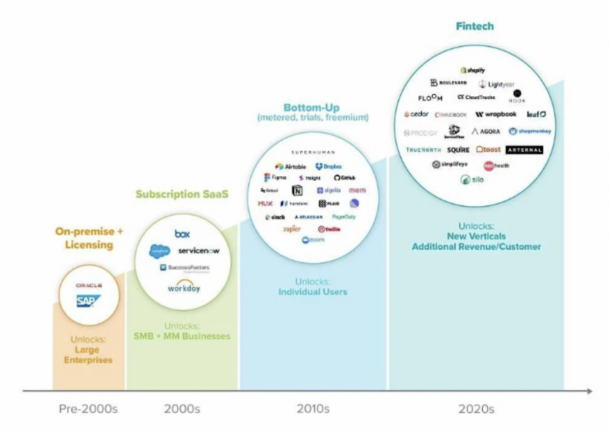
SaaS industry shifts in recent decades (Source: singlegrain.com)
Vertical SaaS companies have been showing impressive and resilient results in recent years. Stock market prices show some of these results for proof. For example, pharmaceutical industry software maker Veeva’s share price has exploded and demonstrated its largest growth in the last 5 years, up 558% from 5 years ago to the low 300’s
Vertical SaaS shows these results because of their specialized set of features, lower cost of implementation due to customization being unnecessary, industry word of mouth, lower ownership costs, and quick time to market
